AI in Customer Communications Will Redefine Engagement in the Future
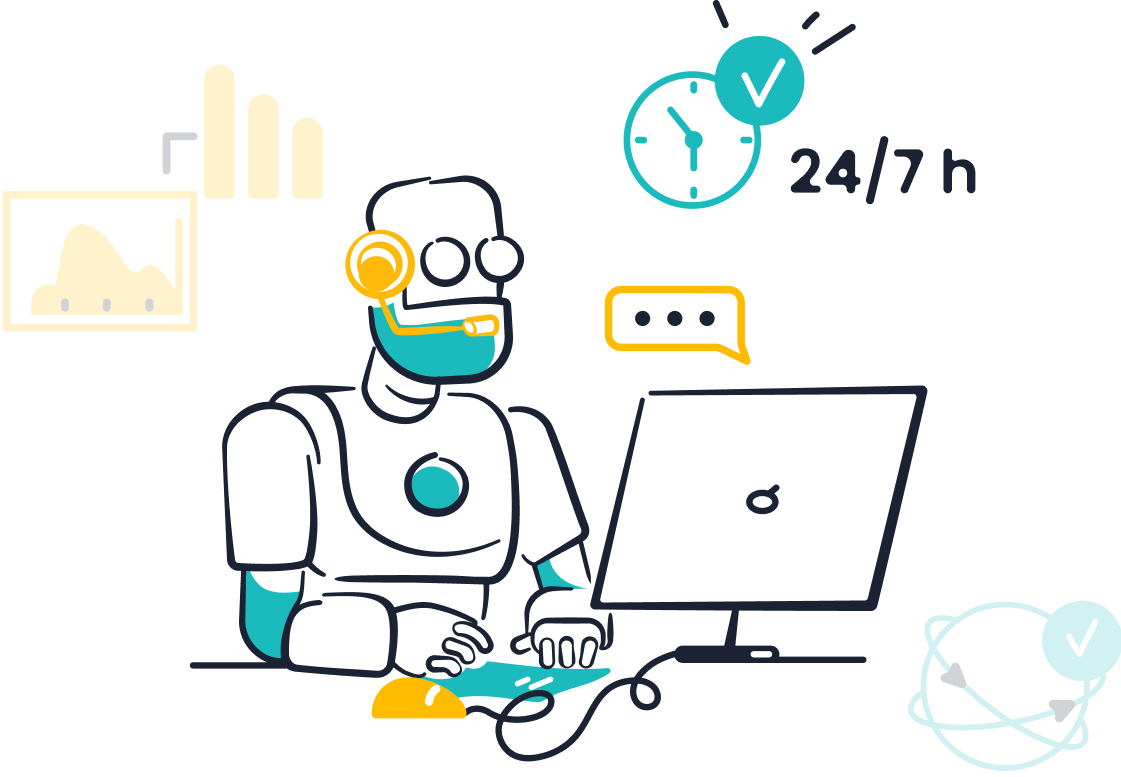
AI in customer communications is changing how brands connect with people. By 2025, 95% of customer interactions will use artificial intelligence, giving fast and personal support. Companies using Sobot AI see higher satisfaction and sales, as shown by OPPO’s results. Businesses must act now to stay ahead. The future of engagement depends on new strategies and tools, like Sobot call center solutions.
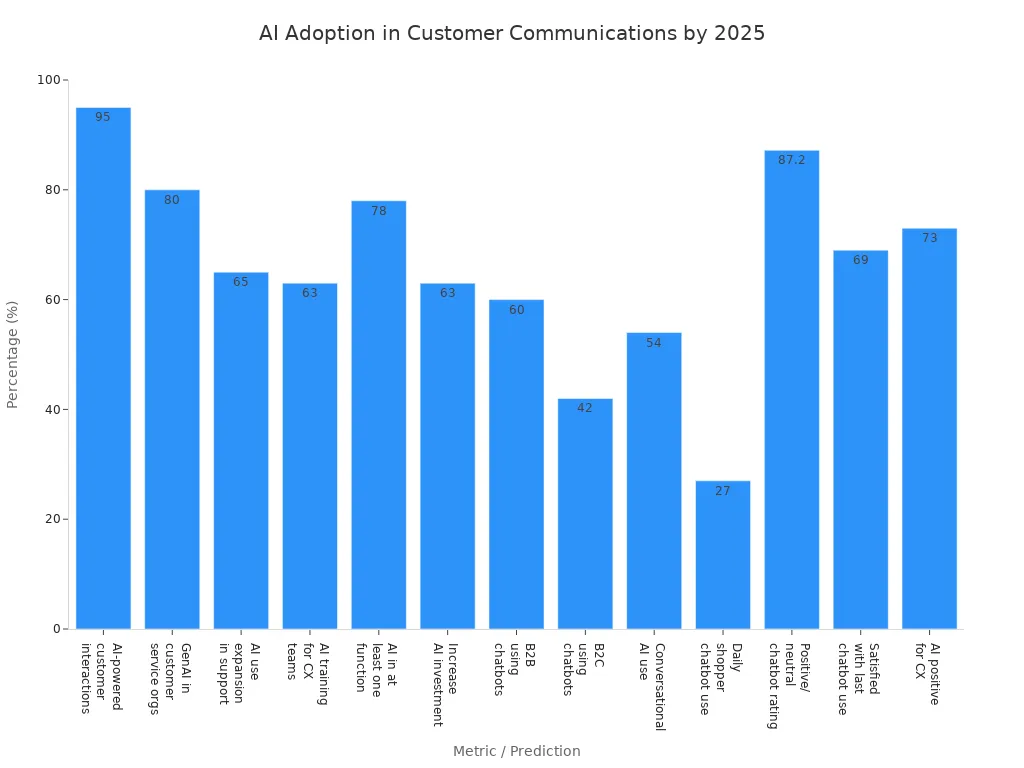
AI in Customer Communications Today
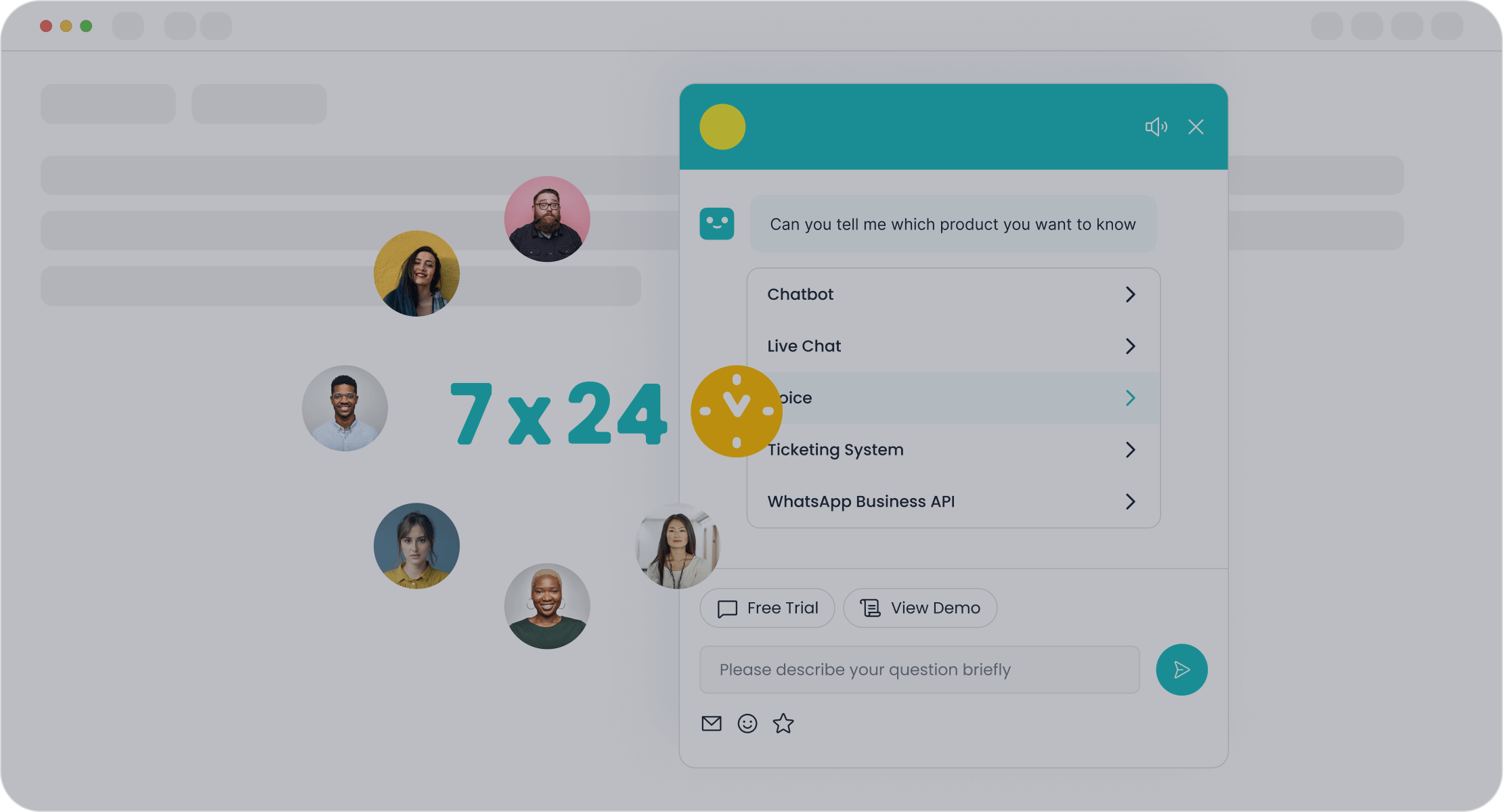
Current Challenges
Businesses face many obstacles when adopting ai in customer communications.
- Balancing automation with human empathy remains difficult. Many customers still prefer live agents, with 88% expressing this preference over automated menus (source).
- Ongoing supervision is necessary because ai can make mistakes without oversight.
- Protecting customer data is critical. Companies must comply with regulations and maintain transparency about data usage.
- Customizing ai-powered customer service solutions for specific needs takes time and resources.
- Managing customer expectations is tough. Customers want ai to work as well as humans, and disappointment can lead to frustration.
- Integrating ai with existing systems like CRM is complex but essential for seamless experiences.
- Achieving high accuracy in natural language processing is challenging due to language diversity and context.
- Building trust and encouraging adoption requires transparency and consistent performance.
- Scalability and flexibility are needed as business needs grow.
Evolving Customer Expectations
Customer service trends show rapid changes in what people expect from ai-powered customer service.
- Customers want faster, more personalized support that traditional methods cannot provide.
- ai in customer communications enables 24/7 support and proactive issue resolution.
- Conversational ai personalizes interactions by analyzing data and previous conversations in real time.
- Sentiment analysis helps ai detect emotions, leading to more empathetic responses.
- Customers expect transparency about when they interact with ai versus humans.
- Easy escalation to human agents is important for complex issues.
- Data security remains a top priority.
- Continuous learning allows ai-powered customer support systems to adapt and improve.
- According to the Zendesk CX Trends Report 2025, 61% of consumers expect more personalized service with ai, and 90% of advanced adopters believe ai will resolve 80% of issues without human help soon (source).
Sobot’s Approach
Sobot addresses the future of customer service with advanced technologies and strategies.
| Strategy/Technology | Description |
|---|---|
| Omnichannel AI | Integrates web, mobile, social media, email, phone, and SMS for seamless customer engagement. |
| Scenario-based AI | Tailors solutions for industries like retail and e-commerce, covering the entire customer journey. |
| Multi-faceted AI | Includes AI Agent, AI Copilot, and AI Insight for automation, agent assistance, and analytics. |
| Generative AI | Uses advanced language models for accurate, fast, and industry-specific responses. |
| Secure AI | Ensures data privacy and compliance with global standards. |
| Sentiment Analysis & Routing | Directs inquiries based on urgency and customer emotion. |
| Self-learning Mechanism | Improves performance through ongoing interaction and feedback. |
| Customizable Workflows | Allows businesses to adapt processes for unique needs. |
| Multi-language Support | Enables global customer service. |
Sobot’s conversational ai and ai-powered customer service solutions help businesses deliver personalized, secure, and scalable support. These innovations set new standards for the future of customer service and align with emerging customer service trends.
AI Predictions for 2025
Hyper-Personalization
Hyper-personalization at scale will define the future of ai in customer service. By 2025, artificial intelligence will anticipate customer needs before they arise. Predictive analytics will analyze purchase history, browsing patterns, and social sentiment. Real-time contextual ai will use location, time, weather, and device type to tailor messages instantly. Multi-modal ai content generation will create personalized text, images, video, and audio for each customer.
Retailers will use ai to customize offers based on biometric feedback and behavior. This approach will improve satisfaction and reduce returns. Financial services will tailor advice and product bundles using transaction patterns and life events. Media companies will personalize content recommendations by analyzing mood and activity data from wearables and social media.
Note: 71% of customers expect personalized experiences, and 76% feel frustrated when they do not receive them (Salesforce Research). Hyper-personalization will become a baseline expectation, not just a competitive advantage.
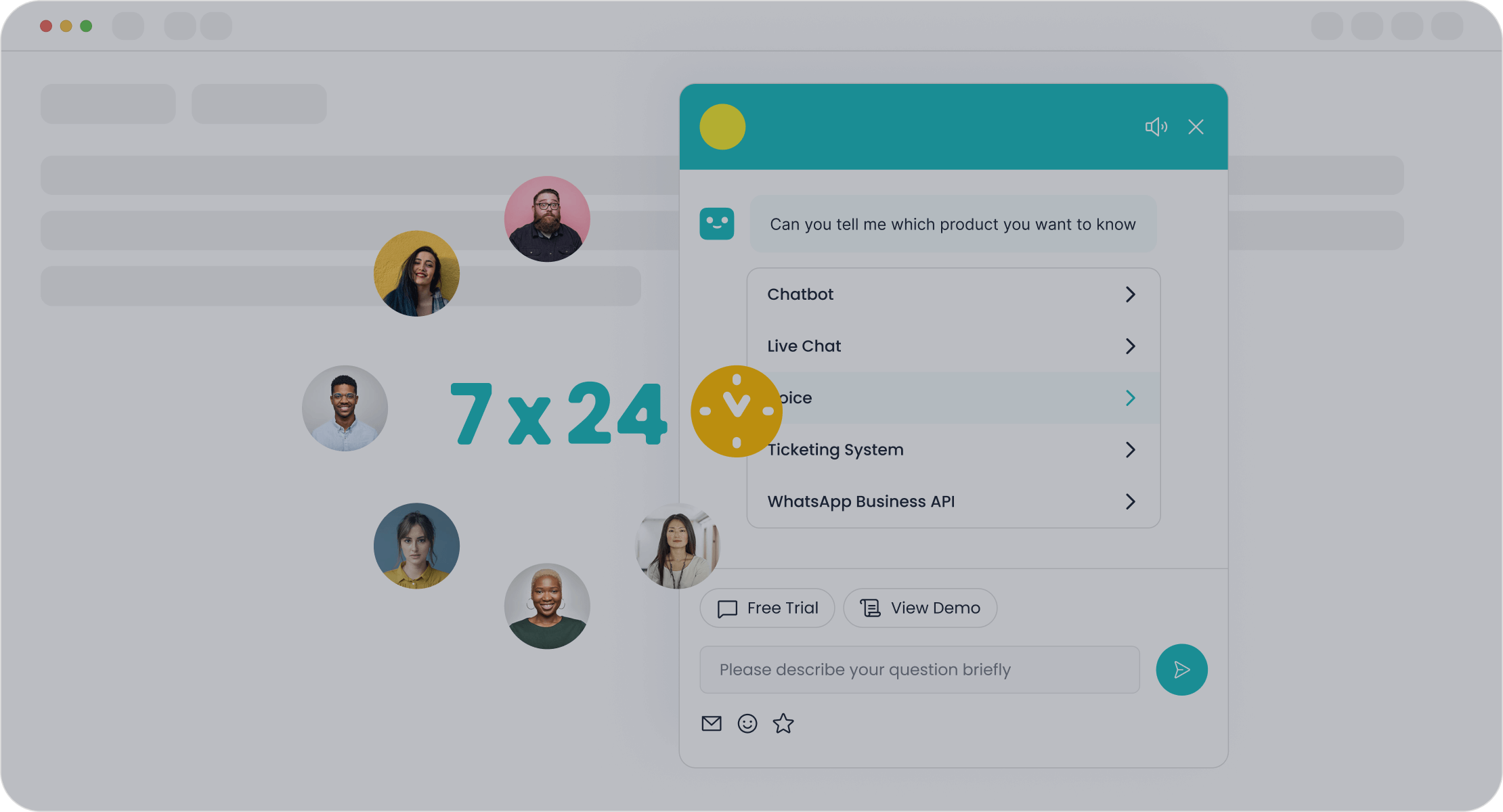
Sobot Chatbot delivers hyper-personalized experiences through ai-powered customer data platforms. These platforms process real-time data and build comprehensive customer profiles. Companies using Sobot report a 25% increase in customer satisfaction and a 15% rise in retention. Sobot’s dynamic content recommendations and journey orchestration tailor onboarding and support to individual needs. The chatbot provides 24/7 ai-powered customer service, offering efficient issue resolution and personalized recommendations across channels.
- Advanced predictive analytics forecast customer behavior.
- Real-time contextual ai tailors messaging dynamically.
- Multi-modal ai generates personalized content.
- Sobot Chatbot uses ai-driven customer experience to increase satisfaction and retention.
- Privacy and data protection remain critical, with robust consent frameworks and encryption.
Omnichannel Integration
Omnichannel support will transform ai-powered customer service by 2025. Customers interact with brands across email, social media, phone, and in-store channels. Businesses must unify these experiences to deliver consistent, personalized journeys. Ai-driven multichannel communication will track preferences and ensure relevant interactions at every touchpoint.
| Aspect | Statistic / Impact |
|---|---|
| Customer Retention Increase | 91% higher year-over-year retention for businesses with omnichannel strategies (Aberdeen). |
| Multi-Channel Usage | 73% of customers use multiple channels during shopping (Harvard Business Review). |
| Sales Revenue Impact | 35% increase in sales revenue for retail clients using ai-powered omnichannel platforms. |
| Conversion Rate Improvement | 30% higher conversion rates with ai-powered journey orchestration. |
| Customer Churn Reduction | 28% reduction in churn for telecom clients leveraging ai omnichannel engagement. |
| Customer Satisfaction Increase | 42% improvement in satisfaction ratings with conversational intelligence features. |
| Data Integration Challenge | 75% of companies cite data integration as a major obstacle in omnichannel adoption. |
| Privacy Compliance Solutions | Use of CDPs and data orchestration tools to unify data and ensure GDPR/CCPA compliance. |
| Hyper-Personalization Stats | 72% of consumers engage only with personalized messages; predictive ai leads to 20% higher sales conversion (Stitch Fix). |
| Cross-Channel Transaction Rate | 85% of customers use multiple channels to complete transactions. |
| Attribution Modeling Importance | 71% of marketers consider attribution modeling crucial for understanding customer behavior. |
Sobot supports seamless omnichannel integration by connecting multiple communication channels. The platform ensures consistent, personalized support and smooth handoffs between ai chatbots and human agents. Sobot’s omnichannel strategy implementation led to a 25% increase in sales and a 30% reduction in customer complaints. Ai-powered customer service platforms like Sobot maintain consistency in tone and information across channels using ai-powered knowledge bases.
Tip: Businesses adopting ai-driven multichannel communication see higher retention, satisfaction, and revenue growth. Omnichannel support is essential for the future of ai in customer service.
Emotional Intelligence
Emotional intelligence will become a core feature of ai-powered customer service. Emotional ai analyzes voice tone, language, facial expressions, and text to gauge customer emotions in real time. This capability allows ai systems to respond empathetically, personalize interactions, and provide proactive support.
- Emotional ai enhances traditional ai by detecting emotions such as happiness, sadness, anger, or frustration.
- Ai-powered voice analysis enables personalized and empathetic responses.
- Emotional ai supports agent performance through real-time coaching and stress management.
- Companies using emotional ai report up to 30% improvement in customer satisfaction and loyalty.
- Omnichannel emotional consistency is achieved by analyzing emotional cues across multiple touchpoints.
Sobot integrates emotional intelligence into its conversational ai systems. The chatbot anticipates customer needs and emotional states before they are expressed. This proactive approach builds trust and loyalty. Sobot’s ai-driven customer experience uses recommendation engines and empathetic chatbots to tailor interactions and support agents. Ethical practices, such as opt-in requirements and transparency, ensure responsible use of emotional ai.
Alert: Emotional intelligence in ai-powered customer service leads to higher satisfaction, loyalty, and employee engagement. Responsible use requires transparency and customer consent.
The ai predictions for 2025 point to a future where hyper-personalization, omnichannel support, and emotional intelligence drive the next wave of customer experience innovation. Sobot’s solutions exemplify these trends, setting new standards for personalized customer service and ai-driven multichannel communication.
CX Trends in 2025
The landscape of customer experience continues to evolve rapidly. Businesses now focus on delivering seamless, human-centered customer experiences powered by advanced AI. The most important cx trends in 2025 revolve around empowering customers, predicting needs, and providing instant support. Companies that embrace these trends will lead in customer satisfaction and loyalty.
Advanced Self-Service
Advanced self-service options have become a cornerstone of customer service trends. Customers want to solve problems independently before reaching out to support. AI-powered virtual assistants, chatbots, and intelligent search systems now guide users through complex workflows with ease. These tools use real-time data and natural language processing to understand intent and provide instant, relevant answers.
| Aspect | Evidence / Impact | Description |
|---|---|---|
| Customer Independent Resolution | 81% of customers try to solve issues independently before contacting support | Shows the importance of self-service as the first customer support step. |
| AI Interaction Handling | AI handles up to 85% of customer interactions | Demonstrates AI’s capacity to autonomously manage a large volume of queries. |
| Customer Experience Improvement | 30-40% improvement in customer experience metrics | Indicates measurable enhancement in satisfaction due to AI self-service. |
| Virtual Assistant Accuracy | Intelligent Virtual Assistants achieve 95% accuracy in understanding intent | Highlights advanced NLP capabilities improving interaction quality. |
| Resolution Rate Increase | 35% boost in resolution rates with AI-powered IVAs | Shows AI’s effectiveness in solving customer issues faster and more accurately. |
| Handling Time Reduction | 20% cut in handling times in knowledge-intensive industries | Reflects efficiency gains from AI-optimized knowledge bases. |
| Customer Satisfaction Growth | 10-15% annual improvement in customer satisfaction | Demonstrates ongoing positive impact on customer satisfaction. |
| Call Volume Reduction | AI chatbots handle 80% of routine inquiries | Reduces load on human agents, improving operational scalability. |
| Productivity Increase | 25-30% increase in contact center productivity | Shows operational efficiency gains from AI automation. |
| Customer Satisfaction Scores | 15-20% increase in satisfaction scores with 24/7 AI support | Emphasizes benefits of always-available AI support, especially in global markets. |
| Routing Efficiency | 15-20% improvement in call routing efficiency | AI optimizes escalation and routing, reducing wait times and improving experience. |
| Customer Loyalty | 25% increase in customer loyalty through AI personalization | Personalized AI interactions foster stronger customer relationships. |
| Customer Effort Reduction | 40% reduction in customer effort scores with predictive AI | AI anticipates needs, making self-service smoother and more intuitive. |

AI self-service solutions now empower customers to resolve issues at any time. These systems provide 24/7 support, instant resolutions, and high containment rates for routine inquiries. Companies see a 30% reduction in service expenses and a 40% drop in call traffic after deploying AI chatbots (IBM Watson Assistant). Sobot’s AI Solution for retail and e-commerce stands out as a leader in this space. Sobot’s platform delivers consistent brand experiences across channels, automates routine tasks, and personalizes interactions using real-time data. Retailers using Sobot report a 25% increase in customer loyalty and a 15-20% rise in satisfaction scores.
OPPO’s success story highlights the impact of advanced self-service. By implementing Sobot’s Chatbot and ticketing system, OPPO achieved an 83% chatbot resolution rate and a 57% increase in repurchase rates. The chatbot handled repetitive queries, freeing agents to focus on complex issues. This approach improved efficiency and customer satisfaction, setting a benchmark for customer experience in the industry (OPPO Case Study).
Predictive Analytics
Predictive analytics has become a game-changer in customer experience. AI now processes vast amounts of real-time data from purchase history, browsing behavior, and social media activity. This analysis uncovers patterns that manual review cannot detect. Businesses use these insights to anticipate customer needs, personalize offers, and deliver timely support.
Predictive analytics breaks down data silos and creates a unified view of each customer. Machine learning models refine predictions over time, making recommendations more accurate and relevant. Companies using predictive analytics see a 10-15% increase in sales and a 75% preference among customers for personalized recommendations (McKinsey). AI-powered chatbots leverage these insights to reduce support queries by up to 30% and improve satisfaction.
In 2025, predictive analytics will allow businesses to proactively address concerns and tailor communications. AI will send personalized updates and promotions throughout the customer journey. Sentiment analysis powered by natural language processing will provide real-time insights into customer emotions, helping brands adjust strategies and improve satisfaction. Tools like Sobot’s AI Solution integrate predictive analytics to optimize marketing, inventory, and support, ensuring seamless and trustworthy customer experiences.
Real-Time Support
Real-time support has become a defining feature of ai-driven cx solutions. Customers expect instant answers and seamless transitions between channels. AI-powered chatbots now provide 24/7 availability, handle high volumes of interactions, and escalate complex issues to human agents when needed.
- AI-powered chatbots deliver instant, consistent support and reduce wait times.
- Voice chatbots enable natural spoken dialogue, improving accessibility.
- Predictive analytics anticipate customer needs and personalize services.
- Agent Assist tools provide real-time AI support to human agents, suggesting responses and retrieving information quickly.
- Omnichannel support integrates communication channels, ensuring a unified experience.
- Multilingual AI support offers accurate responses in multiple languages, enabling global scalability.
- Sentiment analysis tools analyze emotional cues in real time, tailoring responses and enhancing satisfaction.
Note: 81% of consumers believe AI is essential to modern customer service, and 74% say voice AI significantly improves their experience (Salesforce Research).
Sobot’s AI Solution for retail and e-commerce demonstrates the power of real-time support. The platform provides 24/7 assistance, automates routine inquiries, and ensures consistent brand messaging across channels. Businesses using Sobot save up to 2.5 billion hours annually and boost productivity by up to 400%. KFC, for example, uses Sobot’s AI to analyze purchase history and suggest menu items, enhancing the shopping experience. OPPO’s chatbot, powered by Sobot, delivers instant resolutions and maintains high customer satisfaction, as seen in their 94% positive feedback rate.
The cx trends in 2025 show that advanced self-service, predictive analytics, and real-time support are shaping the future of customer experience. Companies that invest in these AI-driven cx solutions will meet rising expectations, foster loyalty, and gain a competitive edge. As customer service trends continue to evolve, the focus remains on delivering human-centered customer experiences powered by real-time data and intelligent automation.
Future of the Contact Center
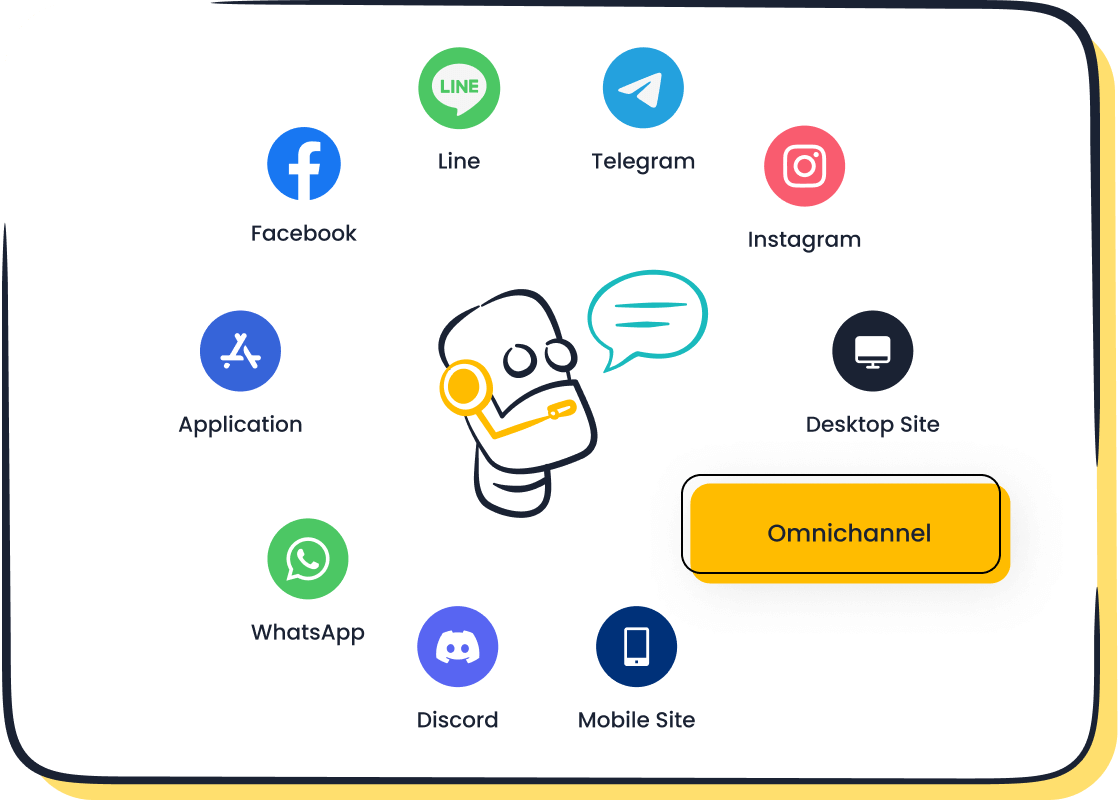
Automation and Human Touch
The future of the contact center will rely on a seamless blend of automation and human empathy. AI-powered customer service systems automate repetitive tasks such as data entry, call routing, and FAQs. Human agents focus on complex, emotional, and ethical interactions. This balance ensures efficiency without losing the personal connection customers value. AI-driven multichannel communication platforms detect customer emotions and trigger timely handoffs to human agents. CRM integrations provide agents with customer history, enabling smooth transitions and avoiding repetition. Most customer support professionals expect to work alongside AI, not be replaced. Automation enhances consistency and workforce management, while humans deliver empathy and creative problem-solving. Contact center automation trends show that advanced chatbots handle routine tasks, freeing agents to build relationships and resolve escalations. AI-powered sentiment analysis supports these transitions, maintaining high customer satisfaction.
Agent Productivity
AI-powered customer service tools transform agent productivity. Unified agent workspaces consolidate multiple platforms into a single interface, reducing time spent searching for information. Smart routing directs queries to the most suitable agents, improving efficiency. AI-powered knowledge access connects sources and reduces search time by up to 30%. Predictive analytics optimize workforce scheduling, balancing workloads and reducing burnout. Training and live coaching powered by AI accelerate onboarding and provide real-time feedback. Self-service tools lower ticket volumes, allowing agents to focus on complex problems. For example, Texas Bank increased its first-call resolution rate by 16%, saving over $1.4 million and boosting customer satisfaction by 17% (source). Elisa improved its first-call resolution by 42% using AI agents. These improvements demonstrate how the future of customer service depends on AI-powered systems that enhance agent performance and customer experience.
| Performance Metric | Improvement Description |
|---|---|
| Automation of repetitive tasks | AI handles routine inquiries and FAQs, reducing workload and errors. |
| Smart routing | AI directs queries to the right agents, improving efficiency. |
| Unified agent workspace | Consolidates tools and data, speeding up response times. |
| AI-powered knowledge access | Connects sources, reduces search time by 20-30%, cuts compliance mistakes by 50%. |
| Average handle time (AHT) | AI reduces AHT by up to 30%. |
| First-call resolution (FCR) | AI-guided conversations improve FCR from 40% to 80%. |
| Workforce management | Predictive analytics optimize staffing, reduce burnout. |
| Training and live coaching | AI accelerates onboarding and enhances agent skills. |
| Self-service tools | AI-powered self-service reduces ticket volume. |
Sobot’s Omnichannel Solutions
Sobot’s Omnichannel Solutions set a new standard for the future of customer service. The platform integrates communication channels such as websites, mobile apps, social platforms (Facebook, Instagram, WhatsApp), email, phone calls, and SMS (Sobot Official Website). AI-powered voicebots handle inbound and outbound calls, providing instant, personalized support. Scenario-based AI tailors solutions for industry-specific needs, especially retail and e-commerce, supporting the entire purchase journey. Multi-faceted AI supports customers with accurate, humanized service, agents with reply suggestions and summaries, and administrators with operational dashboards. Generative AI delivers professional, industry-oriented responses using advanced language models. Sobot prioritizes data privacy and security through encryption, access controls, and regular audits. Regional data centers ensure compliance with global regulations. Detailed analytics and predictive capabilities optimize customer service operations. Sobot’s platform enables ai-driven multichannel communication, ensuring seamless omnichannel support and consistent customer experience. These contact center automation trends position Sobot as a leader in the future of ai in customer service.
Tip: Businesses adopting Sobot’s Omnichannel Solutions gain efficiency, improved customer experience, and cost savings, preparing for the future of the contact center.
Security and Ethics in AI
Data Privacy
Data privacy stands as a critical concern for ai-powered customer service platforms. Companies must ensure transparency about what data they collect, why they collect it, and how they process it. Customers expect clear information and control over their personal data. Organizations should only collect necessary data and use it for stated purposes. They must limit storage duration and provide options for access, correction, and deletion. Shadow AI systems sometimes collect data without documentation, increasing risks. User-generated content, such as support logs and chatbot transcripts, can expose personally identifiable information (PII). Misaligned consent occurs when companies reuse data for secondary purposes without permission. Large language models embed personal data deeply, making complete deletion difficult, even when laws like GDPR and CCPA require it (GDPR, CCPA). Robust data governance helps manage these risks and protects customer trust.
- Transparency in data collection and processing
- Purpose limitation and data minimization
- Storage limitation and informed consent
- Customer control over data
- Risks of algorithmic bias and discrimination
Compliance Standards
Compliance standards guide the ethical use of ai in customer communications. Organizations must follow regulations such as GDPR for data privacy, HIPAA for healthcare data, and GLBA for financial information. The EU AI Act categorizes AI systems by risk and sets strict requirements for high-risk platforms. The NIST AI Risk Management Framework offers guidelines for fairness, transparency, and security. ISO/IEC 42001 standardizes AI governance, helping companies document processes and assess risks. FTC guidance warns against deceptive or discriminatory AI practices. U.S. federal and state laws, including executive orders, shape compliance for ai-powered customer service (NIST, ISO/IEC 42001). Companies must ensure transparency in AI decision-making and maintain human oversight for high-risk systems.
| Standard | Focus Area | Industry Example |
|---|---|---|
| GDPR/CCPA | Data privacy, transparency | Retail, e-commerce |
| HIPAA | Healthcare data protection | Health services |
| GLBA | Financial privacy | Banking, finance |
| EU AI Act | Risk, accountability | Customer communication |
| ISO/IEC 42001 | AI governance | All industries |
| NIST Framework | Fairness, security | Technology, enterprise |
Building Trust
Building trust in ai-driven multichannel communication requires clear strategies. AI-driven personalization creates tailored experiences, making customers feel valued. Predictive analytics anticipate needs, reducing friction and improving satisfaction. Seamless omnichannel experiences maintain context across platforms, lowering customer effort. AI-enhanced customer support, such as chatbots and virtual assistants, provides timely and efficient assistance. Companies that prioritize transparency, responsiveness, and ethical practices foster loyalty and confidence in ai-powered customer service.
Tip: Trust grows when customers see consistent, personalized, and secure interactions. Companies should communicate openly about AI use and offer easy ways for customers to manage their data.
Strategies for Success
Technology Integration
Successful adoption of ai-powered customer service begins with clear objectives. Leaders must define goals such as reducing response times or improving customer satisfaction. They select ai tools that match business needs, including chatbots, analytics, or voice recognition. Integration with existing platforms like CRM and helpdesk systems ensures a unified customer journey. Sobot’s platform streamlines this process by connecting communication channels—web, app, social media, email, calls, and SMS—into one system. Agents access synchronized customer data, enabling personalized, context-aware responses. Companies should pilot ai-powered customer service solutions before full deployment, monitor performance, and optimize workflows. Sobot’s omnichannel and scenario-based ai supports industry-specific needs, making integration seamless and scalable (Sobot AI Platform).
Best Practices for Technology Integration:
- Set clear objectives for ai use.
- Choose solutions that fit business needs.
- Integrate ai with existing systems.
- Train ai with quality data.
- Design intuitive interactions.
- Enable escalation to human agents.
- Monitor performance and feedback.
- Educate staff on ai capabilities.
Workforce Training
Empowering employees is vital for the future of customer service. Organizations must train staff to use ai-powered customer service tools confidently. Training programs should focus on understanding ai functionality, designing effective prompts, and collaborating with ai agents. Leaders identify realistic opportunities and balance automation with human expertise. Sobot’s platform supports easy onboarding and ongoing training, helping teams adapt quickly. Employees learn to engage in conversational dialogue with ai, create custom instructions, and personalize outputs. A people-first mindset ensures that technology enhances—not replaces—human talent. Gamification and rewards motivate staff to embrace new tools, while clear policies on ethical ai use build trust.
Workforce Training Tips:
- Develop comprehensive training programs.
- Encourage iterative interaction with ai.
- Collaborate with support teams to address pain points.
- Start with small pilots to build acceptance.
Measuring Impact
Organizations must measure the impact of ai-powered customer service using clear metrics. Tracking revenue growth, process times, and cost savings reveals operational efficiency. Customer satisfaction scores, Net Promoter Score (NPS), and retention rates show improvements in the customer journey. Sobot’s analytics dashboard provides over 300 reports and thousands of indicators for optimization. Leaders monitor ai accuracy, automation rates, and employee adoption to guide strategy.
| Metric Category | Specific Metrics | Explanation |
|---|---|---|
| AI Performance | Accuracy in handling queries | Measures speed and satisfaction. |
| Automation | Percentage of tasks automated | Shows efficiency gains. |
| Operational Efficiency | Cost per interaction, FCR, AHT | Tracks savings and resolution effectiveness. |
| Customer Success | CSAT, NPS, Retention Rate | Reflects happiness and loyalty. |
| Employee Adoption | Usage intensity, top agent utilization | Indicates cultural and operational adoption. |
Tip: Regularly review these metrics to refine ai-powered customer service strategies and maximize results.
AI continues to reshape customer communications, driving efficiency and personalization.
- AI automates routine tasks, analyzes data, and enables 24/7 support.
- AI-powered chatbots engage customers in human-like conversations, improving satisfaction and retention.
- AI advances emotional intelligence, allowing systems to respond to customer emotions.
Sobot leads in AI-driven customer engagement by prioritizing data privacy, security, and ethical practices. Their platform balances automation with human touch, helping businesses grow and build loyalty. Companies should explore solutions like Sobot’s Chatbot to stay ahead. The future promises smarter, more meaningful customer experiences.
FAQ
What is AI in customer communications?
AI in customer communications uses artificial intelligence to automate and enhance how businesses interact with customers. AI-powered customer service tools, like chatbots, provide instant support, answer questions, and personalize experiences across channels. These solutions help companies improve satisfaction and efficiency.
How does Sobot’s AI-powered customer service improve efficiency?
Sobot’s AI-powered customer service automates routine tasks, answers common questions, and assists agents. The platform operates 24/7, reducing wait times and service costs. Businesses using Sobot report up to 70% higher productivity and 50% lower expenses. Learn more.
Can Sobot’s chatbot support multiple languages?
Yes. Sobot’s AI chatbot supports multiple languages. It interacts with customers in their preferred language, making global customer service seamless and accessible. This feature helps businesses reach wider audiences and improve satisfaction.
Is AI-powered customer service secure and compliant?
AI-powered customer service platforms like Sobot prioritize data privacy and compliance. They use encryption, follow GDPR and CCPA standards, and provide transparent data practices. Companies can trust these systems to protect customer information. Read about GDPR.
What results did OPPO achieve with Sobot’s AI solution?
OPPO used Sobot’s chatbot and ticketing system to handle high inquiry volumes. The company achieved an 83% chatbot resolution rate, a 94% positive feedback rate, and a 57% increase in repurchase rates. See the OPPO case study.
See Also
How AI-Powered Agents Are Transforming Customer Support
A Complete Guide To Deploying Omnichannel Contact Centers
Discover The Leading Cloud-Based Contact Centers For 2025
Best Voice Of Customer Platforms To Use In 2024
Comprehensive Reviews Of Leading Contact Center Solutions 2024
